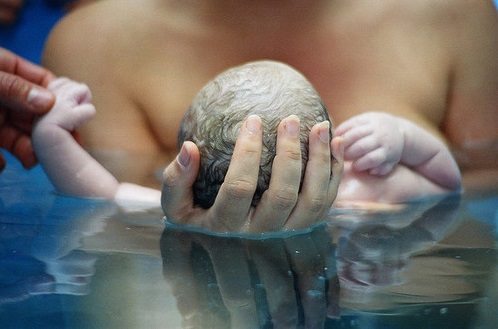Pros And Cons Of Water Births
What do Gisele Bündchen, Jennifer Connelly and Pamela Anderson have in common (other than being celebrities)? Why, it’s giving birth in a water tub at home, of course!
"I wanted to be very aware and present during the birth. … I didn't want to be drugged up” said Bündchen about her decision to avoid a hospital delivery.
Some call it a fad, others a healthier alternative, but water births are an increasing trend throughout the world — particularly in North America and the UK. With relatively easy, if not always affordable, access to hospitals, maternity homes and associated medication for labour, why are so many women choosing this alternate method? We take a look at the pros and cons of this risky choice.
The process of water birth involves being in a tub of warm water for at least some part of the delivery. Women may choose to stay in the water until they start pushing or stay in it for the entire duration so the baby comes out submerged in water. As the fetus has already been inside amniotic fluid for the gestation period, parents and professionals providing this service hope that coming out into a similar environment will be healthier for the baby and less stressful for the mother.
Pros:
- With our long, hot showers and bubble baths, we already know that warm water is very soothing and comforting. The same thought extends to a mother during contractions. Water can help reduce stress-related hormones, relieving some of the pain and making the birthing process easier. It can also help release anxiety, reducing the risk of high blood pressure.
- Buoyancy in the tub will reduce the mother’s body weight, allowing her to move around with less difficulty, and as a result helping her try different positions until she finds the most comfortable one. It can also allow for improved blood circulation in the uterus, as well as more efficient contractions, leading to more oxygen for the baby and less pain for the mother.
- The perineum can relax and become more elasticized in water, limiting the incident and severity of tears and the subsequent episiotomy and stitches.
- For those mothers seeking the privacy and comfort of their homes and close family members, giving birth inside the four walls of their own home will be an attractive idea.
-
These benefits can greatly help reduce the need of common medication taken during labour. One such medication is local anesthesia, used to numb the area around the vagina if stitches are needed in case of a tear. Then there's regional anesthesia — spinal anesthesia, or most commonly the epidural, given to reduce the pain associated with
 contractions. It's injected to the lower back to numb the nerves so a wider part of the body can remain relatively pain-free while the mother is still awake. The many potential side-effects of an epidural include having only parts of your body numb while the other feel pain, itching or fever, low mobility, needing a catheter to empty the bladder, prolonging the pushing stage of labour, increasing the need of forceps or a vacuum to get the baby out with the wrong positioning inside the uterus, and nerve damage leading to temporary or permanent (in extreme cases) paralysis in certain parts of the body.
contractions. It's injected to the lower back to numb the nerves so a wider part of the body can remain relatively pain-free while the mother is still awake. The many potential side-effects of an epidural include having only parts of your body numb while the other feel pain, itching or fever, low mobility, needing a catheter to empty the bladder, prolonging the pushing stage of labour, increasing the need of forceps or a vacuum to get the baby out with the wrong positioning inside the uterus, and nerve damage leading to temporary or permanent (in extreme cases) paralysis in certain parts of the body.
Cons:
- There's an increase in the risk of infections for both mother and baby in the birthing pool.
- Contractions may not be significantly lower in intensity, resulting in a last-minute rush to the hospital, as midwives aren't authorized or qualified to deliver anesthesia.
- Most labour complications fall out of a midwife’s expertise and will require a doctor’s help. Monitoring baby’s heartbeat, slow labour, bleeding during labour, high blood pressure, meconium (baby’s first poo) detected in pool water, or the mother fainting or getting drowsy, among other problems, will all require getting the mother transported into emergency care at a hospital as quickly and safely as possible. Delayed medical help can have a grave negative impact on both mother and child.
- Bowels empty as the baby comes out, and if the mess isn't cleaned up swiftly, there's a great risk of the baby getting infected by the debris, resulting in pneumonia or other life-threatening infections.
- While healthy babies do have a “dive reflex” (they won't breathe under water by instinct), there's still a risk of the baby trying to take a breath under water, inhaling water and cutting off the oxygen supply.
- The umbilical cord can snap with the baby coming up to the surface too fast.
When Should Water Birth Be Avoided?
- If the mother has herpes, as it can transfer very easily in water.
- If baby’s position is breeched.
- If there are signs of excessive bleeding or maternal infection.
- If there will be multiple births (twins, triplets et cetera).
- If baby is coming more than two weeks early.
- If there's severe meconium, indicating distress for the baby.
You should note that there aren't many statistics or studies that prove the effectiveness of one birth method over another. The infant mortality rate is about equal, and maternal health and well-being will vary case by case. That said, the American Congress of Obstetricians and Gynecologists (ACOG) and the American Academy of Pediatrics (AAP) have jointly denounced the practice. They have suggested that, due to a lack of proper and unbiased evidence that proves the case for water birth, water births should only take place experimentally for clinical studies.
If you're considering a water birth, do consult a certified healthcare provider to ensure that you are a good candidate for the method. You must also ensure that your midwife is certified by the state or country you reside in.
The midwife must be a:
- Certified Professional Midwife (CPM) [United States & Canada]
- Certified Midwife (CM) [United States]
- Certified Nurse Midwife (CNM) [United States]
- Nurse and Midwifery Council (NMC) Registered professional [United Kingdom]
 Water births are still rare in India. Some hospitals have staff that are experienced or have facilities to assist with pool births. However, there is no regulatory body to administer midwife certification for home water births. If you're planning a water birth in India, ensure you visit a participating hospital. The Hinduja Healthcare Centre (Mumbai), The Birthing Sanctuary (Goa) and Fortis Mamma Mia (New Delhi) are among the few facilities in India providing water birth options.
Water births are still rare in India. Some hospitals have staff that are experienced or have facilities to assist with pool births. However, there is no regulatory body to administer midwife certification for home water births. If you're planning a water birth in India, ensure you visit a participating hospital. The Hinduja Healthcare Centre (Mumbai), The Birthing Sanctuary (Goa) and Fortis Mamma Mia (New Delhi) are among the few facilities in India providing water birth options.
Whether you choose epidural-assisted or natural water birth, choose the best option for yourself and your child with proper research and healthcare providers' advice.
Sources:
babycenter.ca, webmd.com, celebuzz.com, journals.lww.com,
americanpregnancy.org
Featured Image: exaltbirthservices.com
Image 2: naturalchildbirthalexegypt.blogspot.com
Image 3 showcasing the Hinduja Hospital: facebook.com
Farah Khan | Editorial Director
Author
Farah Khan manages the editorial department at ANOKHI LIFE, overseeing content production, publishing, and the annual editorial calendar, while also supporting operations, projects, systems, events, and vendor coordination.


















































































































